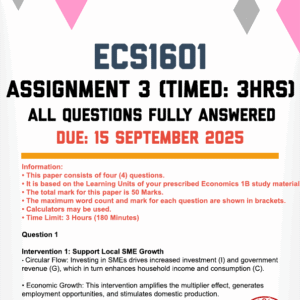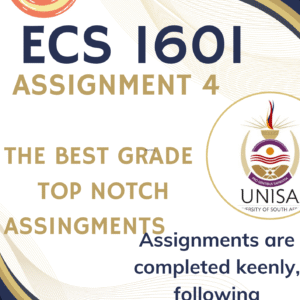Description
ECS1601 Assignment 7 2024 | Due 2 November 2024. All questions answered. Question 1
1.1. Suppose you live in South Africa and have the option to buy proudly South African
products or international brands. With reference to the circular flow of goods and services and
the circular flow of income and spending between households, firms, government and the foreign
sector, provide an explanation as to why it is better to purchase the proudly South African
products and also explain the opportunity costs of buying international items instead of those
produced locally.
Question 2
2. The following question is based on the passage below:
Mauritius’ economy has proven otherwise resilient to global economic shocks, including those
stemming from the war in Ukraine, which has affected revenues from tourism arrivals. GDP growth
rebounded by a relatively modest 3.5% in 2021 and accelerated to an estimated 8.3% in 2022,
supported by a strong recovery in tourism despite headwinds from the war in Ukraine. GDP growth is
projected to moderate to around 5.0% in 2023 as economic activities gradually return to normal.
2.1. With the aid of a diagram, explain how the money market in Maurituius will be affected by
the country’s change in economic growth in 2023. The direction of any changes should be clearly
indicated by using arrows. 2.2. What effect will a change in the price of copper, as described in Extract 2A, have on the
foreign exchange market of Zambia where the same quantity of copper is exported regardless of
price change? Include a diagram in your answer.
Question 3
3. Read the following news clip and answer the question.
News extract 3A
Africa’s Inflation Among Region’s Most Urgent Challenges
In sub-Saharan Africa, inflation has been driven less by domestic activity than in advanced economies.
Instead, external developments have shaped the path of inflation since the start of the pandemic. They
include the sharp spike in global commodity prices, swings in the exchange rate, global supply chain
disruptions, and natural disasters.
In the case of food, the prices of key staples such as maize and wheat have increased since 2019,
contributing two-thirds of overall inflation in fragile states and one-half elsewhere in the region.
Higher global energy prices and the strong dollar have also fed through to inflation indirectly, via
transportation and tradable goods like household products.
Source: International Monetary Fund 3.1. You’re an economic adviser to the Central Bank and National Treasury and you’re asked to
advise both on:
I. With reference to news reported in Extract 3A, explain what type of inflation is likely to be
triggered by rising commodity prices for Sub-Saharan countries that are commodity exporters
and why. Also, explain the influence of this inflation on the distribution of income and wealth
among economic participants.
II. The appropriate steps to address the inflation mentioned above.
4. Have a look at the following diagram and answer questions 4.1 and 4.1 that follow:
4.1. With reference to the above diagram, calculate the equilibrium level of income before the
introduction of government spending and proportional income tax. Show all calculation steps. 4.2. With reference to the above diagram, if national income (Y) is R462 million, calculate the
induced consumption after the introduction of government spending and proportional income
tax. Show all calculation steps.
4.3. With the consumption function in the Keynesian Model with the foreign sector taken into
consideration: If South African National Development Plan 2030 envisions that economic output
will be R 7 854 Bn by 2030 however in 2023 the current output is R4 782 Bn. The NDP 2030 has
earmarked Foreign Direct Investment as an intervention to increase long term economic growth.
In addition to this, the marginal propensity to consume is 0.81, and the marginal propensity to
import is 0.12. Calculate the required increase in Investment from 2023 to 2030, ceteris paribus?












Reviews
There are no reviews yet.